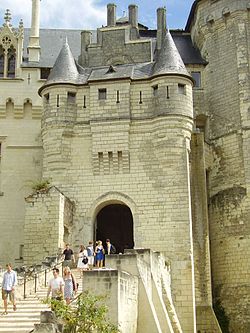- Château de Saumur
-
Located in the French town of Saumur, in the Maine-et-Loire département, the Château de Saumur was originally constructed in the 10th century[1] by Theobald I, Count of Blois, as a fortified stronghold against Norman predations. It overlooks the confluence of the Loire and the Thouet. In 1026 it came into the hands of Fulk Nerra, count of Anjou, who bequeathed it to his Plantagenet heirs. Following its destruction in 1067, the château was rebuilt by Henry II of England in the later 12th century.
Contents
History
In the early part of the 13th century, Philip II of France made Saumur part of his royal domain. The page for September in the Tres Riches Heures du Duc de Berry depicts the Chateau as it looked in 1410. It changed hands several times until 1589 when the Protestant King Henri IV (of France and Navarre) gave the castle to Duplessis-Mornay.
In 1621 the castle was converted into an army barracks. Nearly two centuries later it was converted into a state prison under Napoleon Bonaparte.
In the first part of the 20th century, the city of Saumur acquired the castle and began a restoration program to house the museum of the decorative arts. In line with the Saumur area's equestrian tradition and its famous "Cadre Noir", the castle also serves as a Museum of the Horse. The castle has a dungeon and watchtower, and houses the Musée de la Figurine-Jouet, a collection of very old toys and figurines of soldiers, kings of France, and clowns.
The Château de Saumur has been listed as a monument historique by the French Ministry of Culture since 1862. As of 2008, there are a total of 46 buildings and structures in Saumur which are designated a Monument Historique - see the French national database Mérimée [2]. Most of the monuments are built in the lovely soft local stone known as tuffeau. Amongst the most important monuments are the great Château de Saumur itself which stands high overlooking the town, and the nearby Château de Beaulieu which stands just 200 metres from the south bank of the Loire river; designed by the renowned architect Jean Drapeau, it is recognised for its light and elegant architecture. Amongst the other Monuments Historiques are the church of Saint-Pierre in the Place St Pierre in the centre of Saumur, and the Château de Briacé which is located on the north side of the river. The architecture of Saumur is very well described in the book: Saumur - Promenade D'architectures, by Marie Jane Durand, and published by the Tourism Office of Saumur.
See also
Notes
External links
- Ministry of Culture database entry for Château de Saumur (French)
- Ministry of Culture database entry for Château de Beaulieu (French)
- Ministry of Culture photos
- Photos of Château Château de Saumur and other Loire castles
- http://perso.orange.fr/saumur-jadis/lieux/chateau.htm
Châteaux of the Loire Valley Amboise • Angers • Azay-le-Rideau • Blois • La Bourdaisière • Chambord • Chaumont • Chenonceau • Châteaudun • Cheverny • Langeais • Loches • Menars • Montreuil-Bellay • Montsoreau • Plessis-Bourré • Le Rivau • Saumur • Sully • Talcy • Troussay • Ussé • Valençay • VillandryCategories:- Châteaux of the Loire Valley
- Buildings and structures in Maine-et-Loire
- Official historical monuments of France
Wikimedia Foundation. 2010.




